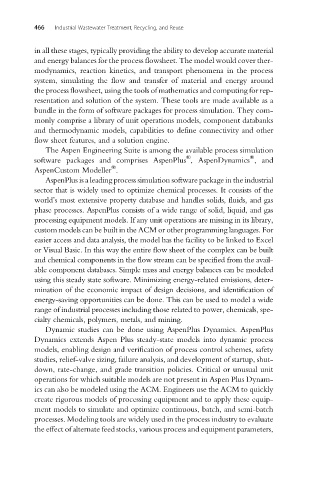Page 496 - Industrial Wastewater Treatment, Recycling and Reuse
P. 496
466 Industrial Wastewater Treatment, Recycling, and Reuse
in all these stages, typically providing the ability to develop accurate material
and energy balances for the process flowsheet. The model would cover ther-
modynamics, reaction kinetics, and transport phenomena in the process
system, simulating the flow and transfer of material and energy around
the process flowsheet, using the tools of mathematics and computing for rep-
resentation and solution of the system. These tools are made available as a
bundle in the form of software packages for process simulation. They com-
monly comprise a library of unit operations models, component databanks
and thermodynamic models, capabilities to define connectivity and other
flow sheet features, and a solution engine.
The Aspen Engineering Suite is among the available process simulation
® ®
software packages and comprises AspenPlus , AspenDynamics , and
®
AspenCustom Modeller .
AspenPlus is a leading process simulation software package in the industrial
sector that is widely used to optimize chemical processes. It consists of the
world’s most extensive property database and handles solids, fluids, and gas
phase processes. AspenPlus consists of a wide range of solid, liquid, and gas
processing equipment models. If any unit operations are missing in its library,
custom models can be built in the ACM or other programming languages. For
easier access and data analysis, the model has the facility to be linked to Excel
or Visual Basic. In this way the entire flow sheet of the complex can be built
and chemical components in the flow stream can be specified from the avail-
able component databases. Simple mass and energy balances can be modeled
using this steady state software. Minimizing energy-related emissions, deter-
mination of the economic impact of design decisions, and identification of
energy-saving opportunities can be done. This can be used to model a wide
range of industrial processes including those related to power, chemicals, spe-
cialty chemicals, polymers, metals, and mining.
Dynamic studies can be done using AspenPlus Dynamics. AspenPlus
Dynamics extends Aspen Plus steady-state models into dynamic process
models, enabling design and verification of process control schemes, safety
studies, relief-valve sizing, failure analysis, and development of startup, shut-
down, rate-change, and grade transition policies. Critical or unusual unit
operations for which suitable models are not present in Aspen Plus Dynam-
ics can also be modeled using the ACM. Engineers use the ACM to quickly
create rigorous models of processing equipment and to apply these equip-
ment models to simulate and optimize continuous, batch, and semi-batch
processes. Modeling tools are widely used in the process industry to evaluate
the effect of alternate feed stocks, various process and equipment parameters,

